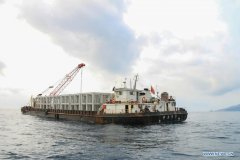Home>>
Scientists explore fatigue-resistant materials inspired by mussels(Xinhua) 15:20, June 28, 2023
BEIJING, June 28 (Xinhua) -- Chinese scientists have discovered the mechanism behind a mussel's remarkable resistance to fatigue during the countless repetitions of opening and closing its shells throughout its lifespan.
Through a 10-year-long research on Cristaria plicata, a freshwater mussel, the scientists unveiled the mechanism responsible for the bivalve hinge's resistance to fatigue, and have proposed a new principle for designing fatigue-resistant materials with deformability, according to a research paper recently published in the journal Science.
Fatigue poses a challenge for living organisms. During activities involving repeated loads, such as running, jumping and chewing, fatigue failure could lead to injury or death. Artificial structures containing brittle materials also experience such failure. As a result, there is a pressing need to explore and develop deformable materials with high fatigue resistance.
The team of researchers from the University of Science and Technology of China (USTC) drew inspiration from mussels, whose hinge connects two shells and bears repeated deformation in their opening and closing motions while maintaining stable function without failure.
"The hinge is really amazing," said Mao Libo, a member of the research team from the USTC, noting that it has a fan-shaped mineralized tissue containing plenty of brittle calcium carbonates, which cannot withstand large deformation. However, the hinge undergoes substantial deformation during the motions of the shells.
"We tried to figure out how mussels balance this contradiction between the use of brittle materials and the need for deformation," Mao said.
However, analyzing natural biomaterials poses a great challenge to materials scientists due to their unknown composition and complex structure, Mao added.
The research team designed a test device to verify the hinge's fatigue-resistance ability. They found that the hinge showed no signs of fatigue even after enduring 1.5 million deformations and continued to support the opening and closing of the two shells.
By scanning the hinge, the team discovered that brittle calcium carbonate nanowires were aligned radially in the fan-shaped tissue of the hinge and embedded in a resilient matrix.
The resilient organic matrix reduces stress concentration within the tissue and avoids the breakage of nanowires, said Meng Xiangsen, a member of the research team from the USTC and the first author of the paper.
Through a multiscale structural design, the hard-soft complex in the tissue of hinge coordinates deformation and translates external loads from radial direction to circumferential direction during the movement of shells, Meng noted.
Inspired by this mechanism from nature, the research team developed a composite material of brittle glass fiber and polymer, and successfully verified its fatigue resistance under repeated deformations.
The findings integrate a lot of different techniques to understand the fatigue-resistant properties of bivalve hinge tissue and encourage further research work using bio-inspired composites for designing new materials with enhanced fatigue resistance, said a reviewer of the journal.
(Web editor: Zhang Kaiwei, Liang Jun)











